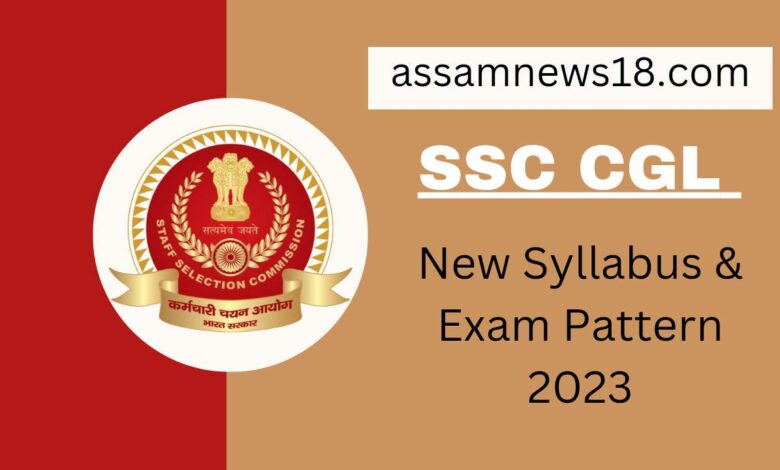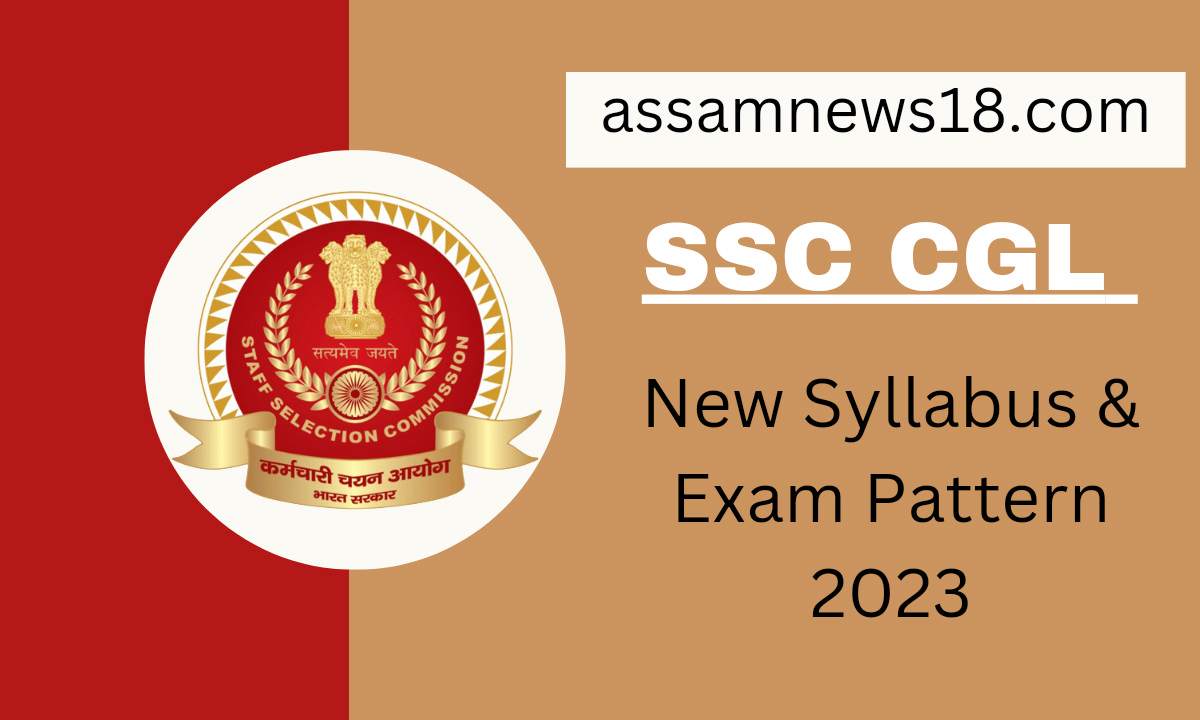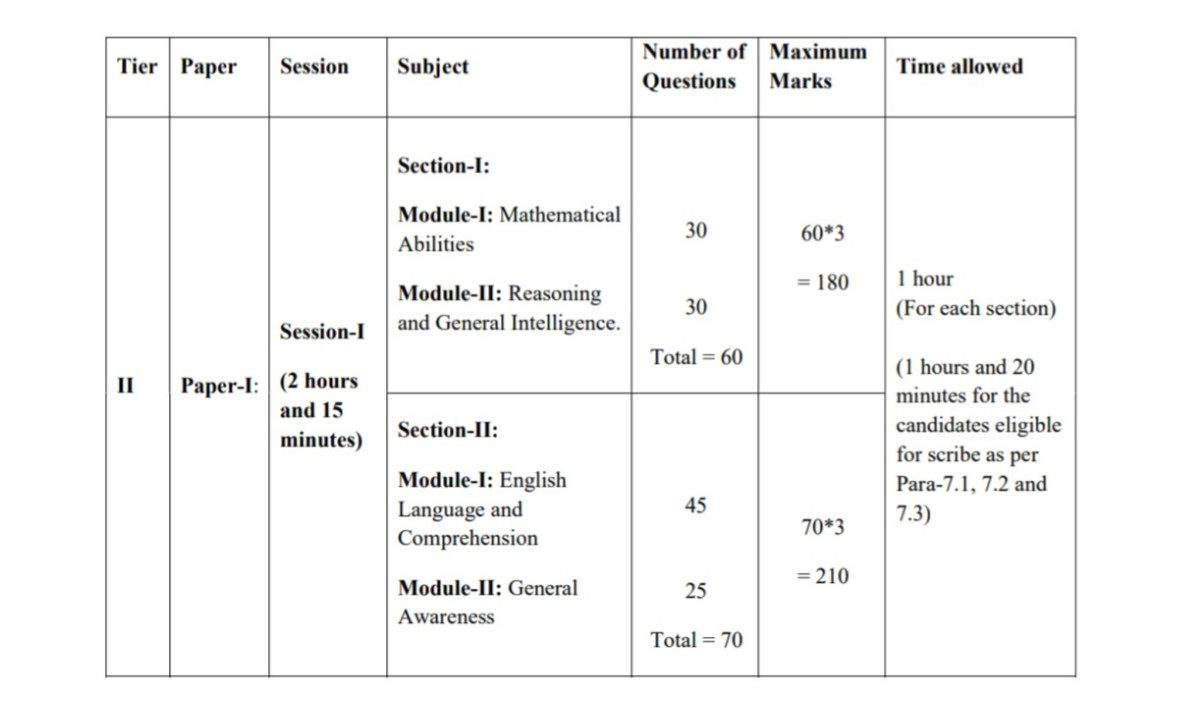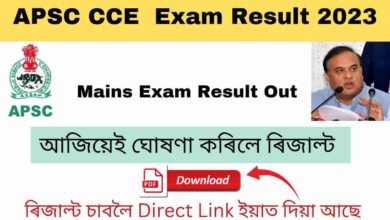
SSC CGL Exam Syllabus 2023 : The Staff Selection Commission (SSC) has released the notification for the SSC CGL Exam 2023, and along with New Syllabus and Exam Pattern. As an aspirant, it is essential to stay updated with the changes in the exam pattern and syllabus to score well in the exam.The SSC CGL Exam 2023 will consist of two phases – Tier I and Tier II. Candidates will have to clear each phase depending on the requirement of the different posts. The exam pattern for both tiers is given below.

SSC CGL New Syllabus & Exam Pattern Overview
| Name of Organisation | Staff Selection Commission |
| Name of Department | Group ‘B’ & Group ‘C’ |
| Vacancy | 7500 ( Aprx..) |
| Post Name | Assistant Audit Officer/Assistant Accounts Officer, Junior Statistical Officer, Statistical Investigator Grade-II, Research Assistant in National Human Rights Commission (NHRC), and other posts |
| Starting Date of Online Application | 03/04/2023 |
| Last Date of Online Application | 03/05/2023 |
| Tier 1 (CBT) Exam Date | July2023 |
| Tier 2 (CBT) Exam Date | To be Notified |
| Application Mode | Online |
| SSC CGL Selection Process | Tier I, Tier II, Document Verification |
SSC CGL Tier 1 Syllabus 2023
The Tier 1 syllabus comprises four subjects i.e.
| Subjects | No. of Questions | Maximum Marks | Time Allowed |
| General Intelligence & Reasoning | 25 | 50 | |
| General Awareness | 25 | 50 | 1 Hour (1Hour 20 Minutes Except some Posts) |
| Quantative Aptitude | 25 | 50 | |
| English Comprehension | 25 | 50 |
Syllabus for General Intelligence & Reasoning
|
Syllabus for General Awareness
|
Syllabus for Quantitative Aptitude
|
Syllabus for English Comprehension
|
SSC CGL Exam Syllabus for Tier 2
The Tier-II syllabus comprises three papers i.e Paper-I, Paper-II, and Paper-III. Paper-I is compulsory for all the posts and the other two papers are post-specific. Candidates can check the detailed topics for the Tier I exam in the table shared below:


Module 1 of Session 1 of Paper 1 (Mathematical Abilities)
| Topics | Sub Topics |
| Number System |
|
| Fundamental arithmetical operations |
|
| Algebra |
|
| Geometry |
|
| Mensuration |
|
| Trigonometry |
|
| Statistics & Probability |
|
Module 2 of Section 1 of Paper 1 ( Reasoning & General Intelligence)
|
Module 1 of Section 2 of Paper 1 ( English language & Comprehension)
|
Module 2 of Section 2 of Paper 1 ( General Awareness)
|
Module 1 of Section 3 of Paer1 (Computer Proficiency)
| Topics | Sub Topics |
| Computer Basics |
|
| Software | Windows Operating system including basics of Microsoft Office like MS word, MS Excel and Power Point etc |
| Working with the internet & e- mails | e-Banking, Managing an E-mail Account, Downloading & Uploading, Web Browsing & Searching |
| Basics of Networking & cyber-security | Networking devices and protocols, Network and information security threats (like hacking, virus, worms, Trojan etc.) and preventive measures |
SSC CGL Tier 2 Paper 2 Syllabus (Statistics)
| Subjects | Topics |
| Collection, Classification and Presentation of Statistical Data | Primary and Secondary data, Methods of data collection; Tabulation of data; Graphs and charts; Frequency distributions; Diagrammatic presentation of frequency distributions |
| 2. Measures of Central Tendency | Common measures of central tendency – mean median and mode; Partition values- quartiles, deciles, percentiles. |
| 3. Measures of Dispersion- Common measures of Dispersion | range, quartile deviations, mean deviation and standard deviation; Measures of relative dispersion. |
| 4. Moments, Skewness and Kurtosis | Different types of moments and their relationship; the meaning of skewness and kurtosis; different measures of skewness and kurtosis. |
| 5. Correlation and Regression | Scatter diagram; simple correlation coefficient; simple regression lines; Spearman‟s rank correlation; Measures of association of attributes; Multiple regression; Multiple and partial correlation (For three variables only). |
| 6. Probability Theory | Meaning of probability; Different definitions of probability; Conditional probability; Compound probability; Independent events; Bayes‟ theorem. |
| 7. Random Variable and Probability Distributions | Random variable; Probability functions; Expectation and Variance of a random variable; Higher moments of a random variable; Binomial, Poisson, Normal and Exponential distributions; Joint distribution of two random variable (discrete). |
| 8. Sampling Theory | Concept of population and sample; Parameter and statistic, Sampling and non-sampling errors; Probability and nonprobability sampling techniques(simple random sampling, stratified sampling, multistage sampling, multiphase sampling, cluster sampling, systematic sampling, purposive sampling, convenience sampling and quota sampling); Sampling distribution(statement only); Sample size decisions. |
| 9. Statistical Inference | Point estimation and interval estimation, Properties of a good estimator, Methods of estimation (Moments method, Maximum likelihood method, Least squares method), Testing of hypothesis, Basic concept of testing, Small sample and large sample tests, Tests based on Z, t, Chi-square and F statistic, Confidence intervals. |
| 10. Analysis of Variance | Analysis of one-way classified data and two-way classified data. |
| 11. Time Series Analysis | Components of time series, Determination of trend component by different methods, Measurement of seasonal variation by different methods. |
| 12. Index Numbers | Meaning of Index Numbers, Problems in the construction of index numbers, Types of index number, Different formulae, Base shifting and splicing of index numbers, Cost of living Index Numbers, Uses of Index Numbers. |
SSC CGL Tier 2 Syllabus for Paper 3 (General Studies-Finance and Economics)
Part A : Finance & Accounts
| Subjects | Topics |
| 1. Financial Accounting | Nature and scope, Limitations of Financial Accounting, Basic concepts and Conventions, Generally Accepted Accounting Principles. |
| 2. Basic Concepts of Accounting | Single and double entry, Books of original Entry, Bank Reconciliation, Journal, ledgers, Trial Balance, Rectification of Errors, Manufacturing, Trading, Profit & loss Appropriation Accounts, Balance Sheet Distinction between Capital and Revenue Expenditure, Depreciation Accounting, Valuation of Inventories, Non-profit organisations Accounts, Receipts and Payments and Income & Expenditure Accounts, Bills of Exchange, Self-Balancing Ledgers. |
Part B : Economics & Governance
| 1. Comptroller & Auditor General of India | Constitutional provisions, Role and responsibility. |
| 2. Finance Commission | Role & Functions |
| 3. Basic Concept of Economics and introduction to Micro Economics | Definition, scope and nature of Economics, Methods of economic study and Central problems of an economy and Production possibilities curve. |
| 4. Theory of Demand and Supply | Meaning and determinants of demand, Law of demand and Elasticity of demand, Price, income and cross elasticity; Theory of consumer’s behaviour – Marshallian approach and Indifference curve approach, Meaning and determinants of supply, Law of supply and Elasticity of Supply. |
| 5. Theory of Production and cost | Meaning and Factors of production; Laws of production- Law of variable proportions and Laws of returns to scale. |
| 6. Forms of Market and price determination in different markets | Various forms of markets-Perfect Competition, Monopoly, Monopolistic Competition and Oligopoly and Price determination in these markets. |
| 7. Indian Economy | Nature of the Indian Economy Role of different sectors – Role of Agriculture, Industry and Services – their problems and growth
· National Income of India-Concepts of national income, Different methods of measuring national income · Population-Its size, rate of growth and its implication on economic growth. · Poverty and unemployment- Absolute and relative poverty, types, causes and incidence of unemployment · Infrastructure-Energy, Transportation, Communication |
| 8. Economic Reforms in India | Economic reforms since 1991; Liberalisation, Privatisation, Globalisation and Disinvestment. |
| 9. Money & Banking | Monetary/ Fiscal policy- Role and functions of Reserve Bank of India; functions of commercial Banks/RRB/Payment Banks.
· Budget and Fiscal deficits and Balance of payments. · Fiscal Responsibility and Budget Management Act, 2003. |
| 10. Role of Information Technology in Governance |
NOTE: Questions in module-I of section- I of paper-I (Mathematical Abilities) will be of matriculation level. Questions in module-I of section- II of paper-I (English Language and Comprehension) will be of 10+2 level. Questions in paper-II and paper-III will be of graduation level.
Important Links for SSC CGL Exam 2023
| Official Website | Click Here |
| Online Application Form | Click Here |
| Advertisement Details | Click Here |
| Our WhatsApp Group | Join👍 |




